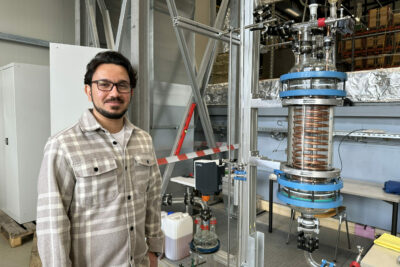The 2nd General Assembly Meeting for RESTORE took place in Vienna from Decmeber 13th – 14th at Technische Universität Wien’s (TU Wien) premises, where productive discussions filled the two-day event.
Throughout the meeting, all project members extensively reviewed the achievements across each work package. Central to the discussions were identifying key challenges and exploring potential solutions, emphasizing their impact on enhancing the competitiveness of the RESTORE project.
The highlight of the meeting was the tour of TU Wien’s thermochemical laboratories, offering all project partners a firsthand view of ongoing work in Thermochemical Energy Storage (TCES). The partners from TU Wien showcased their work on reactors developed since the project’s initiation two years ago. Their 1-2kWth continuously operated TCES serves as the foundation for designing and producing a larger-scale TCES, ranging from 30 to 50 kWth. A lab-scale batch reactor is used to test various thermochemical energy storage materials, with the aim of identifying the most efficient reaction system for the initial scale-up phase. Additionally, a reactor test stand equipped with a heat exchanger is employed to study heat transfer to and from the reactor. This investigation is based on understanding the flow structure of the suspension, crucial for optimizing the TCES process.
RESTORE has also made significant progress on its work on reversible Organic Rankine Cycle (rORC). Partners from Politecnico di Milano showcased their advancements in developing a numerical model to optimize Heat Pump/Organic Rankine Cycle technology and its application across the six Virtual Use Cases of RESTORE. Collaborating with Politecnico di Milano, partners ENERBASQUE and TURBODEN have been focusing on designing components for small and large-scale RESTORE systems, respectively. The outcomes of their work were discussed during the meeting.
On the second day, the SimTech team, responsible for the RESTORE Model with IPSE GO, presented their significant developments, where they announced that the RESTORE Preliminary TCES charging and discharging model is now ready for testing. This achievement marks a crucial milestone as the next phase involves modeling the six Virtual Use Cases using input data specific to RESTORE. SimTech also presented the remarkable function of IPSE GO, facilitating project sharing and embedding on websites for internal and global accessibility, allowing user interaction without needing a platform login. Once extensive testing of this function is completed, it will become available to potential users and stakeholders.
Aside from technical updates, discussions revolved around socio-economic analysis, dissemination strategies, communication methods, and plans for project exploitation.
Looking forward, the upcoming year signifies a crucial phase for the RESTORE project, including the implementation of TCES upscaling and the rORC Prototype in the months ahead. Stay informed to catch all the latest updates on RESTORE’s achievements.
- RESTORE parnters at the 2nd GA Meeting in Vienna
- Meeting hall at Science Center of TU Wien
- Joneid Hasnnejad (TU Wien) with test setup for heat transfer experiments




